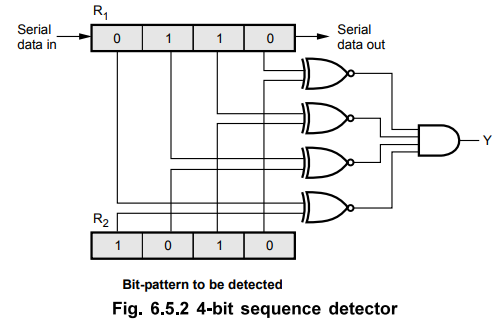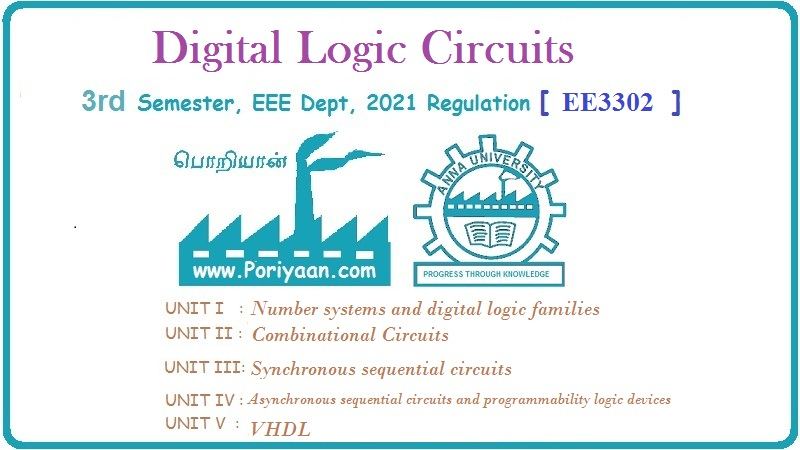Digital Logic Circuits: Unit III: (c) Shift Registers
Applications of Shift Registers
• Primary use of shift register is temporary data storage and bit manipulations. Some of the common applications of shift registers are as discussed below.
Applications of Shift Registers
•
Primary use of shift register is temporary data storage and bit manipulations.
Some of the common applications of shift registers are as discussed below.
1. Delay Line
•
A Serial-In-Serial-Out (SISO) shift register can be used to introduce time
delay At in digital signals. The time delay can be given as
Δt
= N × 1 / fc
where
N is the number of stages (i.e. flip-flops) and fc is the clock
frequency.
•
An input pulse train appears at the output delayed by Δt.
•
The amount of delay can be controlled by the clock frequency or by the number
of flip-flops in the shift register.
2. Serial-to-Parallel Converter
•
A Serial-In-Parallel-Out (SIPO) shift register can be used to convert data in
the serial form to the parallel form.
3. Parallel-to-Serial Converter
•
A Parallel-In-Serial-Out (PISO) shift register can be used to convert data in
the parallel form to the serial form.
4. Shift Register Cunters
•
A shift register with the serial output connected back to the serial input is
called shift register counter.
•
The most common shift register counters are the ring counter and the Johnson
counter.
5. Pseudo-Random Binary Sequence (PRBS) Generator
•
A shift register can be used as a pseudo-random binary sequence generator.
•
A suitable feedback is used to generate pseudo-random sequence.
•
The term random here means that the outputs do not cycle through a normal
binary count sequence.
•
The term pseudo here refers to the fact that the sequence is not truly random
because it does cycle through all possible combinations once every 2n - 1 clock
cycles, where n represents the number of shift register stages (number of
flip-flops).
6. Sequence Generator
•
The shift register can be used to generate a particular bit pattern
repetitively.
•
The Fig. 6.5.1 shows the basic block diagram of a sequence generator.

•
Left most flip-flop input accepts the serial input and the right most flip-flop
gives serial data output.
•
The serial data output signal is connected as a serial data in.
•
On every clock pulse the data shift operation takes place.
•
The loaded bit pattern at the serial output is in a sequence.
•
Same bit pattern is again loaded in the register since serial output is
connected serial in of the register. Thus, the circuit generates a particular
bit pattern repetitively.
7. Sequence Detector
•
The shift register can be used to detect the desired sequence.
•
The detection process requires two registers : One register stores the bit
pattern to be detected i.e. R1 and other register accepts the input
data stream i.e. R2
•
Input data stream enters a shift register as serial data in and leaves as
serial out.

•
In every clock cycle, bit-wise comparisons of these two registers are done
using EX-NOR gates as shown in the Fig. 6.5.2. The two-input EX-NOR gate gives
logic high output when both inputs are either low or high, i.e. when both are
equal. When outputs of all the EX-NORs gates are logic high we can say that all
bits are matched and hence the desired bit pattern is detected. The final
output which indicates that the pattern is detected is taken from four-input
AND gate.
•
The 4-bit sequence detector shown in Fig. 6.5.2 can be made programmable by
loading the desired 4-bit data in the register R2.
Review Question
1. Explain the applications of shift registers.
Digital Logic Circuits: Unit III: (c) Shift Registers : Tag: : - Applications of Shift Registers
Related Topics
Related Subjects
Digital Logic Circuits
EE3302 3rd Semester EEE Dept | 2021 Regulation | 3rd Semester EEE Dept 2021 Regulation
